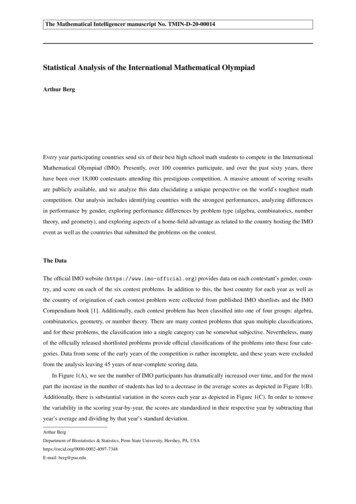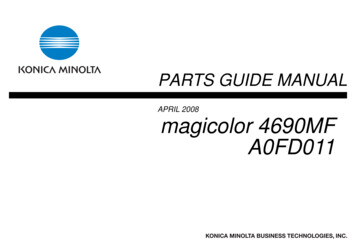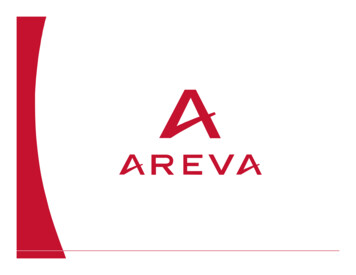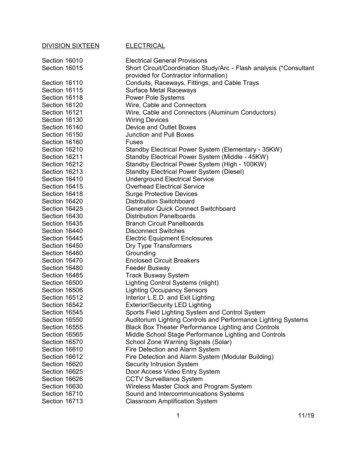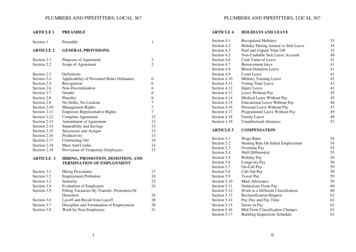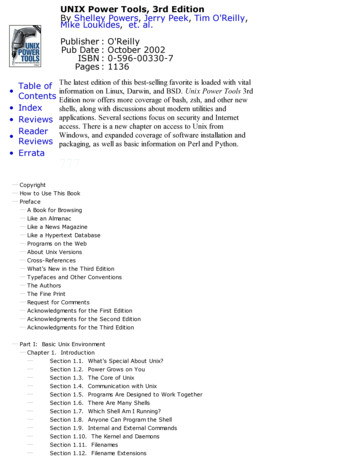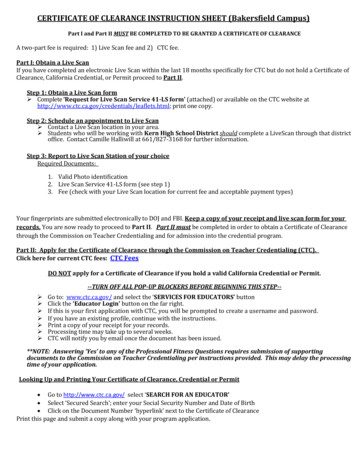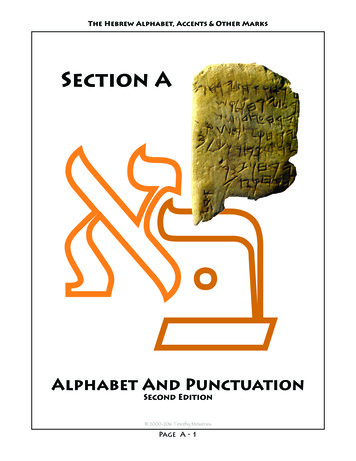
Transcription
The Hebrew Alphabet, Accents & Other MarksSection AAlphabet And PunctuationSecond Edition 2000-2016 Timothy MinistriesPage A - 1
The Hebrew Alphabet, Accents & Other MarksHBRWTh lphbt s hrd t mstr;Rdng bck t frnt's dsstr.Nlss h's rd the clssfds,whr trth, bbrvtd hds,th wld-b rdr f the Bbl,prsntd wth th txt, s lblt trn nd rn wth shrks nd hwlsth Hbrw Scrptrs hv n vwls!AN ALEPH-BET SONGGCGAm GD GGAleph Bet Gimel Dalet, Hey Vav (Hey Vav),aGbCgdGCh whGAm GCG[ pxq rv tD GZay'n Het Tet, Yod Kaf Lamed, Mem Nun (Mem Nun)wzDj f yGklAm G D GSamech Ay'n Pe, Tsade Qof Resh, Shin Tav (Shin Tav) Shin Tav (Shin Tav).sAm Gv tv t v tAleph BetGimmel Dalet,Hey Vav (Hey Vav),Zay'n Het Tet,Yod Kaf Lamed,Mem Nun (Mem Nun)Samech Ay'n Pey,Tsade, Qof, Resh,Shin Tav (Shin Tav)Shin Tav (Shin Tav). 2000-2016 Timothy MinistriesPage A - 2m nmn
The Hebrew Alphabet, Accents & Other MarksContentsHBRW Poem & Aleph-Bet Song. 2Abbreviations. 4Moabite Stone. 5Paleo-Hebrew Script of the Moabite Stone. 6Alphabet Chart. 7Full Vowel Chart. 8Reduced Vowel Chart. 9Special Vowels. 9Vowel Points. 10Horned Or Shining?. 11Diphthongs. 12Guttural Consonants. 13Reading The Sheva. 13Vocalizing The Sheva Diagram. 14What A Dagesh Does. 15BiG DuCk FaT Letters. 15Metheg, Maqqeph & Mappik. 16Fun With Hebrew Accents .17-18 2000-2016 Timothy MinistriesPage A - 3
The Hebrew Alphabet, Accents & Other l Hebrew.Biblia Hebraica Stuttgartensia.A Biblical Hebrew Reference Grammar by van der Merwe, Naudé, andKroeze.Biblical Hebrew: An Introductory Grammar, by Page H. Kelley.A Basic Introduction To Biblical Hebrew by Jo Ann Hackett.A Practical Grammar For Classical Hebrew by J. Weingreen.Pocket Dictionary For The Study Of Biblical Hebrew by Todd J. Murphy.Biblical Hebrew: A Compact Guide by Miles V. Van Pelt.The Essentials Of Biblical Hebrew by Kyle M. Yates, edited by John Joseph Owens. 2000-2016 Timothy MinistriesPage A - 4
The Hebrew Alphabet, Accents & Other MarksAhigh-contrast image of the Moabite Mesha‘ stela from soon after the time of King Solomon,showing an early phase in the devolopment of the paleo-Hebrew script. The stone was amonument erected by king Mesha of Moab to commemorate his victories over Israel. The brokenbut mostly restored stone is now in the Louvre. 2000-2016 Timothy MinistriesPage A - 5
The Hebrew Alphabet, Accents & Other MarksThe paleo-Hebrew script used on the Moabite stela show on the previous page. Images takenfrom Ada Yardeni, The Book Of Hebrew Script: History, Paleography, Script Styles, Calligraphy& Design, (London, UK: The British Library, 1991). 2000-2016 Timothy MinistriesPage A - 6
The Hebrew Alphabet, Accents & Other MarksAlphabet Chart12345678910111213141516Letter dMemNunSamechAyinPronunciationSilent letterB as in Baal,V as in VineG as in GehennaD as in DelilahH as in HallelujahV as in VanityZ as in ZionCH as in BaCHT as in TalentY as in YiddishK as in KishCH as in BaCHL as in LordM as in MaryN as in NazerethS as in SunSilent letter17PeP as in Passion18TsadeTS as in TSar1920Qof2122ReshFinal always fricative,and with silent sheva.PH as in graPHK as in KoheletR as in RabbiShinS as in Sin, SH as in SHadeTavT as in ToilPronounced as S when dotted on the upper left,and SH when dotted on the upper right. 2000-2016 Timothy MinistriesPage A - 7PrintaBbgdhwzjfy ]K klmµnˆs[Pπpx qrcvtBlock.Scripta·bbgdhwztfy·k KklmMn Ns[·ppPxXqrc··cj*Pronounce with a guttural “H” sound.
The Hebrew Alphabet, Accents & Other MarksHebrew Full VowelsNameQamatz (Kamatz Gadol,Qamets)Tsere (Tzere)Tsere YodHiriq Gadol (Hirik Male)Shuruq (Shuruk, Shureq)Holam (Holem)Vav HolamQamatz Qatan (KamatzKatan, Kamats Hatuf, Qamets Hatuf)Patah (Patach)Segol (Seghol)Hiriq (Hireq, Chirik Chaser)Qubbuts (Qibbuts, Kubutz)SignSounded Asb;beybeybia as in yachtWbowOu as in bluee as in entreeLONGey as in theyi as in briefo as in goo as in rowNOTE: Sometimes is not a holam buta vav-holam and should be read as vō;cf.in Neh 9.14 andinPro 10.8. The vav-holam in the latterword is discerned by knowing the word,and by the fact that every syllable mustbegin with a consonant (the syllablecannot begin with an ō sound).wOtwOwx]mitwOx]mitwOb;b'b,bibuo as in dog/o as in morea as in yachte as in bedi as in binu as in blueSHORTNOTE: The vowel signs consist of the marks in regular black tone. The grayed-out b is only providedto show the position of the vowel marks. Also, the h’s (and ch’s) in in vowel names are gutturals,except in Shuruq and Seghol. 2000-2016 Timothy MinistriesPage A - 8
The Hebrew Alphabet, Accents & Other MarksHebrew Reduced VowelsNameSignb]b}b‘b’Sheva (Shva, Shwa)Hatef PatahHatef SegolHatef QamatzPronunciationThe sheva is sounded as a veryshort [e], as in happening, exceptwhen it is silent. Modern Israelis pronounce the three hatafvowels as uh, eh, and o (as inpot) respectively.NOTE: The vowel signs consist of the marks in regular black tone. The grayed-outb is only provided to show the position of the vowel marks.Special VowelsPatah FurtiveNormally, a vowel sign appearing under a word is read after the consonant above it. This rule hasan exception: if the final consonant of a word is a guttural and follows a full accented vowel, thena ' (patah) under that final consonant is furtive and is read first. The word j'Wr, for example, ispronounced roo/ach, not roo/cha.Qamatz Qatan (Qamets Hatuf)Written identically to the normal qamatz (qamatz rachabh), : , the qamatz qatan is a short voweland is recognized by the fact that it appears in a closed, unaccented syllable. By contrast, theregular qamatz appears in an open syllable, or in a closed and accented syllable. Qamatz Qatanoccurs in lK; (Gen 1.21), hm;k]j,; Úl]k;a} (Gen 2.17) and Úr“m;v]yI (Psa 121.7). In some of theseinstances, whether or not the qamatz appears in an open or closed syllable depends upon whetherthe associated sheva is vocal or silent, and vice versa!Shuruq (Shureq)The W sign can function either as a shuruq or as a doubled vav (with dagesh). If it follows a consonant, it is a shuruq (e.g. ËWrB;); if it follows a short vowel, it is a doubled vav, and should have avowel following ( hW:xi). In the word WWq'y“ (Isa 51.5) the first W follows a patah and so is a doubledvav; the second W thus follows a vav and so is a shuruq. 2000-2016 Timothy MinistriesPage A - 9
The Hebrew Alphabet, Accents & Other MarksHebrew Vowel PointsSpoken Hebrew employed vowel sounds from the beginning, but the ancient alphabet used novowel signs. The pronunciation of Hebrew words, written only with consonants, was passeddown orally. When Hebrew scholars of the Middle Ages finally decided that the vowel sounds forwords in the Scriptures had to be signified to preserve the proper pronunciation for subsequentgenerations, they realized that they could not add any letters to the 22-sign alphabet because thewords and letters of Scripture were sacred!1 Neither the spelling of the words, nor the numberof their letters, could be changed. Therefore, rather than add letters to the alphabet (as theGreeks had), Hebrew scholars invented a system of vowel points, tiny symbols, that could beplaced below or above the Hebrew consonants to indicated vowel sounds without changing thetraditional spelling of words in the Scriptures. Around AD 500, several vowel pointing systems weredeveloped, frequently giving different sounds to a text! The Tiberian pointing system eventuallybecame the most popular, and has been used in Hebrew Bibles since the thirteenth century.2To read the words in modern editions of the Hebrew Scriptures, the reader’s eye mustnow track up and down and across to see each vowel and consonant (not to mention accentmarks!). To read the word God, µyhiløa‘, for example (enlarged below), the eye must beginon the right, noting the the aleph and moving downward to see the vowel points, hateph segol(E) under it, then move upward to the left to take in the consonant lamed (L). From there, theeye must move slightly to the left to take in the dot above the top line (O), and then move leftto see the hey (H). Then the eye must see the dot below the hey and move upward to noticethat it is the first mark in the diphthong chiriq gadol (I). Finally, the eye must move left for thefinal letter mem(M). Thus, we read E-L-O-H-I-M (except that we’ve read it the other direction,M-I-H-O-L-E). I only describe this process in detail for your understanding; your eye will trackthis way naturally once you memorize the alphabet and vowel points.µ yhi lo a‘1 Although, from around the time of Ezra and Nehemiah, scribes began to use some consonants to representvowels, namely, aleph, hey, vav and yod. These letters, when used to help the reader recognize vowel sounds, arecalled matres lectionis, “mothers of reading.”2 The Tiberian pointing system has been preserved in what is known today as the Masoretic text. 2000-2016 Timothy MinistriesPage A - 10
The Hebrew Alphabet, Accents & Other MarksHornedOr Shining?When Moses descended from Mt. Sinai with the tablets of the law, did hisface shine (Ex 34.29-30, NASB), orwas he horned (cornuta) as in the LatinVulgate? The answer depends uponthe vowels one chooses to go with theword ˆrq. The word ˆr"q;means “tosend out rays,” but ˆr,q, means “horn.”Jerome apparently chose the latter (andmore common) meaning of the Hebrew word, and translated it “horned”in what became the Vulgate versionof the Bible that Michelangelo used.Michelangelo’s MosesPhotos by Roderick Graciano,June 7, 2013, Rome, Italy 2000-2016 Timothy MinistriesPage A - 11
The Hebrew Alphabet, Accents & Other MarksHebrew DiphthongsNameSignNotesPatah Yodyb'ai as in chai — Patah Yod functionsas a long vowel in that a sheva following it will be vocalQamatz Yodyb;ywOwb;wyb;ybeyb,ybia as in father but held slightly longertoward ou in ought or ai in aisleyWhb;j"Woo-ie or ü-ie as in bouyHolam YodQamatz VavQamatz Yod VavTsere YodSegol YodHiriq Gadol(Hirik Male)Shuruk YodQamatz Hey (Qamatz Male)Vav with furtivePatahoyavSilent yod, so pronounced avey as in theyei as in sleighi as in thinkahü-ahNOTE: The vowel signs consist of the marks in regular black tone. The grayed-out b and j areonly provided to show the position of the vowel marks. Also, the h’s (and ch’s) in vowel namesare gutturals, except in Shuruk Yod and Qamatz Hey. 2000-2016 Timothy MinistriesPage A - 12
The Hebrew Alphabet, Accents & Other MarksThe Guttural ConsonantsThe guttural consonants are a group of letters that are articulated at the back of thethroat, namely: א , ה , ח , ע and ר . These letters cannot take a dagesh forte. This iswhy the definite article (which is normally spelled with a following dagesh forte) isspelled differently when it precedes a guttural letter.The gutturals always take a compound sheva (hataf vowel) instead of a simplevocal sheva. Usually, guttural letters take a hataf patah ( ). Initial aleph, however,often takes the hataf segol ( ), and in rare instances a guttural will take a hatafqamatz ( ).}b‘’A gutural letter will often require a furtive patach when immediately following an accented full vowel, as in רּוח .ַReading the ShevaThe Sheva is vocal when: It is the beginning vowel in a syllable, whether at the beginning or in the middle ofa word. In the middle of a word (but not at the end), it is the second of two shevas together,or under a letter which is doubled (which is the equivalent) with a daghesh forte(the daghesh forte is distinguished by the fact that it is preceded immediately by avowel, regardless of whether it appears in a “beged kefet” letter). In the middle of a word, it follows a syllable with a long vowel or a syllable withan accent.The Sheva is silent when: It appears at the end of a word or of a closed syllable. In the middle of a word, it follows an unaccented short vowel (unless it appearsunder a doubled consonant, and thus becomes a double sheva). In the middle of a word, it is the first of two shevas together. There is a daghesh lene in the consonant immediately following the sheva (as inrB;d]mi ). 2000-2016 Timothy MinistriesPage A - 13
The Hebrew Alphabet, Accents & Other MarksVocalizing the ShevaIs itunder the initialconsonant of theword?YESDoes it followa qenemlui letteror a sibilant that hasdropped its doubling?NODoes itsconsonant follow a long vowelor a meteg?YESNOIs it thesecond of twoconsecutiveshevas?y“w“l]m]n“q]VOCALNOIs it under aconsonant witha dagesh?YESYESE.g., µydil;y“h' inIsa 57.5.YESUnless under thefinal consonant ofthe word, then NOSILENTc]v]s]z“YESIs it under agutteral consonant other thanr? 2000-2016 Timothy MinistriesPage A - 14ahj[
The Hebrew Alphabet, Accents & Other MarksWhat A Dagesh DoesDagesh Lene (Dagesh Kal)The dagesh lene is a dot placed in the bosom of the six letters, B G D K P T,which signifies a retention of the hard pronunciation of the consonants. It changes“fricatives” into “stops.” These letters are often called “beged kefet” letters ( tp,K]dg B]), or less reverently, BiG DuCk FaT letters. Dagesh lene is never precededimmediately by a vowel sound (it may be preceded by a silent sheva as in rB;dm“ )i .Dagesh Forte (Dagesh Chazak)The dagesh forte is a dot which may be placed in the bosom of any letter, exceptfive guttural consonants, a [ h j r. It serves to double the letter. The dagesh fortemay be distinguished from a dagesh lene in that the dagesh forte is alwayspreceded immediately by a vowel, whereas dagesh lene is never precededimmediately by a vowel sound.BiG DucK FaT LettersStops FricativesBGDKPTB as in BoyG as in GirlD as in DoorK as in KittyP as in PopT as in Tallbgdk Ëp πtV as in VineGh as in UghTh as in ThereCh as in BachPh as in PhoneNOTE: Final Kaf cantake a dagesh, as in thefinal words of Gen 12.1;21.16; Psa 73.27.Th as in ThinkNOTE: The blue letters above are the ones which still have a fricative variation in the pronunciation of modern Hebrew. The others have all become stops whether they have a dagesh or not. 2000-2016 Timothy MinistriesPage A - 15
The Hebrew Alphabet, Accents & Other MarksMeteg, Maqqeph& Mappik A meteg (or metheg or methegh “bridle”), also referred to as ma’arik (“lengthener”) and ga‘ya (“raising”), is a secondary accent indicating a (very brief) pause,and that the word will also have an additional accent. A metheg appears as a smallperpendicular stroke under the syllable, to the left of the vowel to be accented,as in µd;a;h â (in BHS it sometimes appears to the right of the vowel). The metegshould not be confused with the sillûq, which looks the same, but only appearsunder the last word of the verse.The meteg is used with the qamets in any position to ensure that it will notbe interpreted as a qamets hatuph. In these cases the metheg closes the syllable(keeping the syllable open and the vowel long), and indicates that the followingsheva is vocal (as in hl;fq] â).The meteg appears with: all vowels that precede a consonant with a hateph vowel, short vowels appearing anomalously in open syllables before theprimary accent, all long vowels that precede a pretonic vocal sheva, qamets and sere in open pretonic or propretonic syllables where ahateph vowel normally appears, long vowels in a closed syllable that precedes a maqqeph, a short vowel in what appears to be a closed syllable to indicate thatthe normal doubling of the following consonant has been dropped:µyliG]r'm]hâ' instead of µyliG]r'M]h.' A maqqeph is a small horizontal bar used to join words which are connectedin thought or utterance. E.g., bwOfAyki. A mappik is a dot sometimes placed in the letter H (hey) when it is final, to indicate that the hey is to be treated as a consonant (guttural) and not as a silentvowel letter. E.g., Hb'G.: 2000-2016 Timothy MinistriesPage A - 16
The Hebrew Alphabet, Accents & Other MarksFun With Hebrew AccentsThe accent marks in our Hebrew scriptures aid not only in reading but also in interpretation. As F.C. Putnam explains,Every word without maqqef in the Hebrew Bible is marked with at least one sign in addition to itsvowel points. These accents, inserted by the Masoretes (c. 500–1000 AD) have three functions: (1)to indicate whether a word should be joined to or separated from the following word; (2) to markthe accented or “tone” syllable; and (3) to indicate a word’s melody for singing (cantillating) thetext.The first function means that the accents can help us read and interpret the text, since theyoutline the verse’s structure. The interpretation that they represent—given the Masoretes’ attention to the text, and the antiquity of their views—should not be overlooked or casually dismissed.1Disjunctive AccentsThe major disjunctive accents are like punctuation marks that signal a pause. They often mark thelast word in a phrase, clause or other unit of thought. They include:Atnach ( ֑ ) ב : Divides a verse into its two major logical sections, regardless of their word length,and marks its word as “in pause.”2Zaqef Qaton ( ב ֔ ) and Zaqef Gadol ( ב ֕ ) : Mark the major division of each of the verse halvesseparated by the Atnach.Silluq with Soph Pasuq ( ) ֽב׃ : These marks always go together, under and after (respectively) thefinal word in a verse (but not necessarily the end of the sentence) and put the word “in pause.”Don’t confuse the Silluq with the Metheg which is identical in appearance (see p. A-16).Conjunctive AccentsGenerally, the conjunctive accents unite only words closely connected in sense, like a noun andan adjective (the closest possible connection between two words is indicated by the Maqqeph,see p. A-6). The conjunctive accents include:Munach ( ב ֣ )Mehuppak ( ב ֤ )Merka, aka Merekha ( ב ֥ )Petucha And SetumaThe Petucha (marked with a )פ indicates the end of an open paragraph, i.e., a paragraph afterwhich the following text begins on a new line. The Setuma (marked by a )ס marks the end of aclosed paragraph, i.e., a paragraph after which the following text continues on the same line.12Frederic Clarke Putnam, Hebrew Bible Insert: A Student’s Guide to the Syntax of Biblical Hebrew (Quakertown, PA:Stylus Publishing, 2002), p. 51.A word “in pause” must have a long vowel in its accented or tone syllable, and therefore, if required, the vowels ofa word in pause will be lengthened. 2000-2016 Timothy MinistriesPage A - 17
The Hebrew Alphabet, Accents & Other MarksRemember that the accent marks in our Hebrew scriptures are intended to aid not only in reading but also in interpretation. However, for us beginners, there are certain accent marks that areconfusing because (a) they consist of multiple marks, and/or (b) they look like a vowel point atfirst glance. These include:Other Disjunctive AccentsThe counterpart to Zaqef Qaton ( ב ֔ ) , namely, Zaqef Gadol ( ב ֕ ) : These accents mark the majordivision of each of the verse halves separated by the Atnach ( ֑ ) ב . The Zaqef Gadol consist oftwo dots stacked vertically, adjacent to a vertical stroke. Don’t mistake the two dots for a sheva;the reduced vowel sheva always appears under a consonant, not above it.Tevir ( ב ֛ ) : This accent, composed of a slanted stroke, followed by a dot, has often made usthink we were seeing a hiriq vowel (as with the word, אָ ָד֛ם , in Gen 1.26). The name of this accent (meaning “broken”), along with the name of the accent Darga, appears in a Hebrew saying,equivalent to our proverb, “Pride goes before a fall”: אחרי דרגא תביר After Darga (to rise up)comes Tebîr (breaking destruction).Legarmeh ( ) ב֣ ׀ : This is the weakest disjunctive accent, comprised of a Munach ( ֣ ) and a following Paseq ( ) ׀ .Segolta ( ֒ ) ב : This accent always follows its word (and so is called a postpositive), whether or notthe final syllable is stressed. In form it mirrors the Segol vowel ( ֶ ) ב , reversing the arrangement ofdots, and always appearing above the consonants (instead of below like the vowel). It indicatesthe first of two main pauses in a verse. The Segolta is always paired with a preceding Zarqa ( ב ֘ )which is also postpositional. See the combination in Gen 8.21:֒ ֣יח הַ ּנִ יח ַֹח ַ ת־ר ֵֶ וַיָּ ַ֣רח יְ הוָה ֮ א Qarne Farah ( ב ֟ ), “horns of a cow,” a fourth-level disjunctive accent.Another Interesting AccentThe rare Shalshelet ( )ב ׀ ,֓ normally followed at the end of the word by the vertical line of thePaseq (aka, psik, pasek). The Shalshelet appears four times in the Pentateuch and is believed toconvey inner turmoil on the part of the subject (Gen 19.16; 24.12; 39.8; Lev 8.23).Accent Under A Doubled ConsonantThe question arises as to which syllable is emphasized when an accent is place under a consonant doubled by a dagesh, as in ִא ּֽמֹו or ( ִמ ָ ּֽמוֶת׃ Proverbs 10.1,2). The rule is that “The accentsign is normally placed above or below the first consonant of the accented syllable.”1 Therefore,since the first consonant of a doubled pair ends a syllable, the stress must go on the syllable begun by the second consonant of the doubled consonant pair.1 Van der Merwe, Christo, Jackie Naudé, Jan Kroeze, A Biblical Hebrew Reference Grammar, electronic ed.(Sheffield: Sheffield Academic Press, 1999). 2000-2016 Timothy MinistriesPage A - 18
Page A - 4 Timothy Ministries he Here Alphaet Accents ther arks Abbreviations BH Biblical Hebrew. BHS Biblia Hebraica Stuttgartensia. MNK A Biblical Hebrew Reference Grammar by van der Merwe, Naudé, and Kroeze. PHK Biblical Hebrew: An Introductory Grammar, by Page H. Kelley. JAH A Basic Introduction To Biblical
